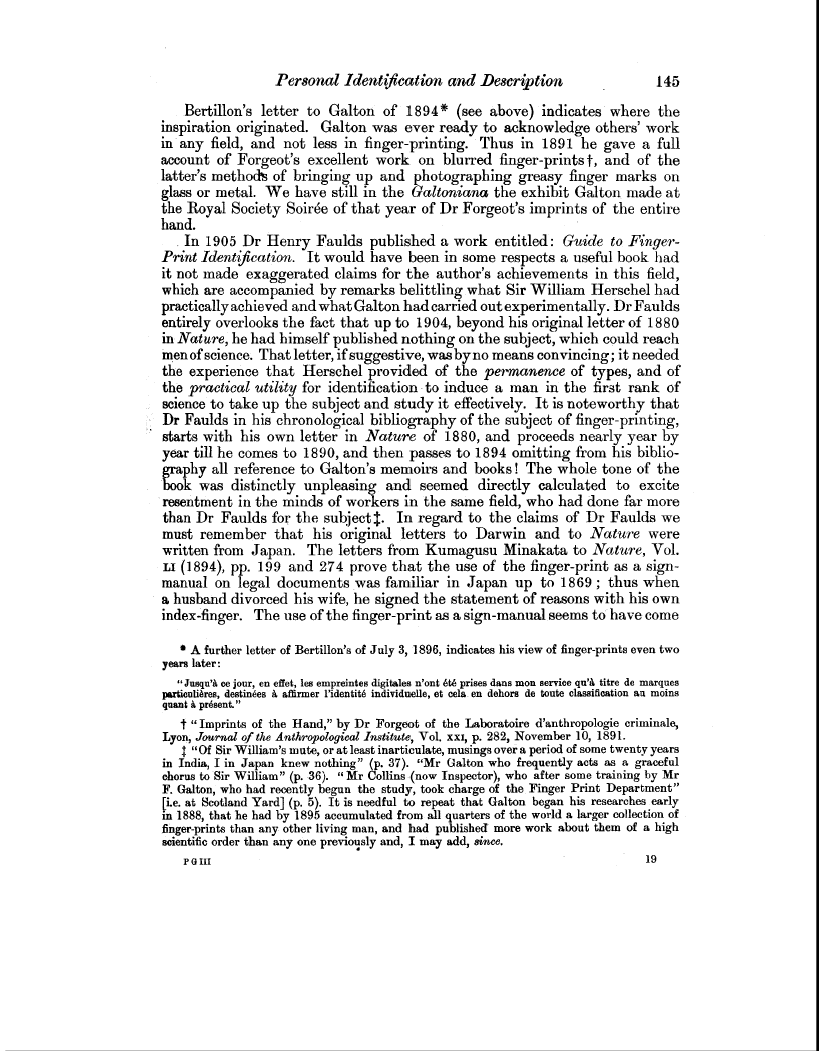| ||||||

OCR Rendition - approximate
Personal Identification and Description 145 Bertillon's letter to Galton of 1894* (see above) indicates where the inspiration originated. Galton was ever ready to acknowledge others' work in any field, and not less in finger-printing. Thus in 1891 he gave a full account of Forgeot's excellent work on blurred finger-prints t, and of the latter's methods of bringing up and photographing greasy finger marks on glass or metal. We have still in the Galtoniana the exhibit Galton made at the Royal Society Soiree of that year of Dr Forgeot's imprints of the entire hand. In 1905 Dr Henry Faulds published a work entitled : Guide to FingerPrint Identification. It would have been in some respects a useful book had it not made exaggerated claims for the author's achievements in this field, which are accompanied by remarks belittling what Sir William Herschel had practically achieved and what Galton had carried out experimentally. Dr Faulds entirely overlooks the fact that up to 1904, beyond his original letter of 1880 in Nature, he had himself published nothing on the subject, which could reach men of science. That letter, if suggestive, was by no means convincing; it needed the experience that Herschel provided of the permanence of types, and of the practical utility for identification to induce a man in the first rank of science to take up the subject and study it effectively. It is noteworthy that Dr Faulds in his chronological bibliography of the subject of finger-printing, starts with his own letter in Nature of 1880, and proceeds nearly year by year till he comes to 1890, and then passes to 1894 omitting from his biblio phy all reference to Galton's memoirs and books ! The whole tone of the k was distinctly unpleasing and seemed directly calculated to excite resentment in the minds of workers in the same field, who had done far more than Dr Faulds for the subject$. In regard to the claims of Dr Faulds we must remember that his original letters to Darwin and to Nature were written from Japan. The letters from Kumagusu Minakata to Nature, Vol. Lz (1894), pp. 199 and 274 prove that the use of the finger-print as a signmanual on legal documents was familiar in Japan up to 1869 ; thus when a husband divorced his wife, he signed the statement of reasons with his own index-finger. The use of the finger-print as a sign-manual seems to have come * A further letter of Bertillon's of July 3, 1896, indicates his view of finger-prints even two years later: "Jnsqu'A ce jour, en effet, les empreintes digitales n'ont ete prises dans mon service qu'b titre de marques partieuligres, destinees l affirmer l'identite individuelle, et cela- en dehors de toute classification an moins quant a present." t "Imprints of the Hand," by Dr Forgeot of the Laboratoire d'anthropologie criminale, Lyon, Journal of the Anthropological Institute, Vol. xxi, p. 282, November 10, 1891. 1 "Of Sir William's mute, or at least inarticulate, musings over a period of some twenty years in India, I in Japan knew nothing" (p. 37). "Mr Galton who frequently acts as a graceful chorus to Sir William" (p. 36). "Mr Collins (now Inspector), who after some training by Mr F. Galton, who had recently begun the study, took charge of the Finger Print Department" (i.e. at Scotland Yard] (p. 5). It is needful to repeat that Galton began his researches early in 1888, that he had by 1895 accumulated from all quarters of the world a larger collection of finger-prints than any other living man, and had published more work about them of a high scientific order than any one previously and, I may add, since. P Q 111 19
|